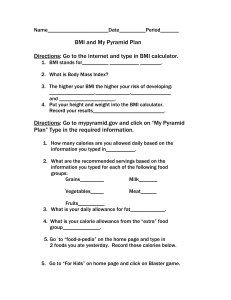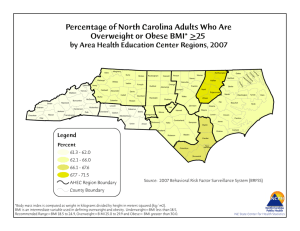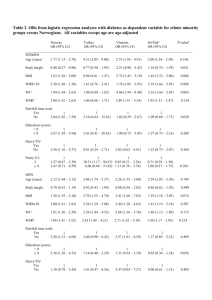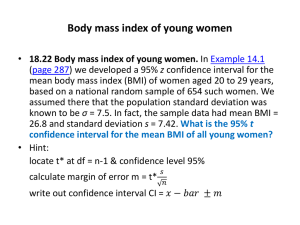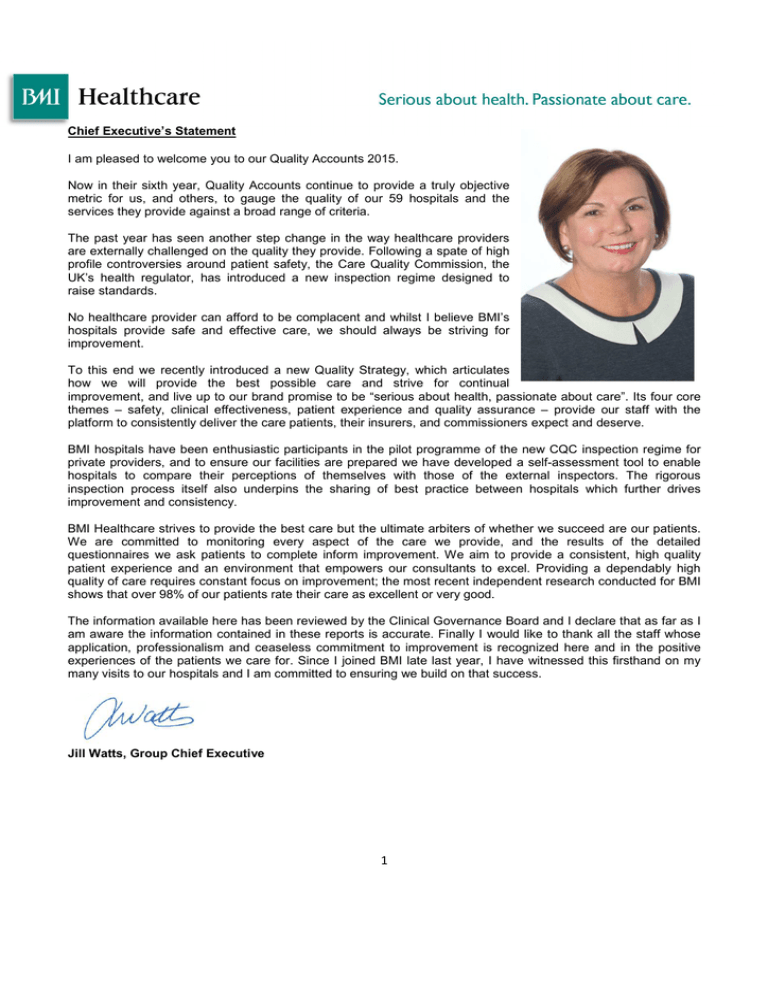
Chief Executive’s Statement
I am pleased to welcome you to our Quality Accounts 2015.
Now in their sixth year, Quality Accounts continue to provide a truly objective
metric for us, and others, to gauge the quality of our 59 hospitals and the
services they provide against a broad range of criteria.
The past year has seen another step change in the way healthcare providers
are externally challenged on the quality they provide. Following a spate of high
profile controversies around patient safety, the Care Quality Commission, the
UK’s health regulator, has introduced a new inspection regime designed to
raise standards.
No healthcare provider can afford to be complacent and whilst I believe BMI’s
hospitals provide safe and effective care, we should always be striving for
improvement.
To this end we recently introduced a new Quality Strategy, which articulates
how we will provide the best possible care and strive for continual
improvement, and live up to our brand promise to be “serious about health, passionate about care”. Its four core
themes – safety, clinical effectiveness, patient experience and quality assurance – provide our staff with the
platform to consistently deliver the care patients, their insurers, and commissioners expect and deserve.
BMI hospitals have been enthusiastic participants in the pilot programme of the new CQC inspection regime for
private providers, and to ensure our facilities are prepared we have developed a self-assessment tool to enable
hospitals to compare their perceptions of themselves with those of the external inspectors. The rigorous
inspection process itself also underpins the sharing of best practice between hospitals which further drives
improvement and consistency.
BMI Healthcare strives to provide the best care but the ultimate arbiters of whether we succeed are our patients.
We are committed to monitoring every aspect of the care we provide, and the results of the detailed
questionnaires we ask patients to complete inform improvement. We aim to provide a consistent, high quality
patient experience and an environment that empowers our consultants to excel. Providing a dependably high
quality of care requires constant focus on improvement; the most recent independent research conducted for BMI
shows that over 98% of our patients rate their care as excellent or very good.
The information available here has been reviewed by the Clinical Governance Board and I declare that as far as I
am aware the information contained in these reports is accurate. Finally I would like to thank all the staff whose
application, professionalism and ceaseless commitment to improvement is recognized here and in the positive
experiences of the patients we care for. Since I joined BMI late last year, I have witnessed this firsthand on my
many visits to our hospitals and I am committed to ensuring we build on that success.
Jill Watts, Group Chief Executive
1
Hospital Information
BMI Healthcare
BMI The Highfield Hospital is part of BMI Healthcare, Britain’s leading provider of independent
healthcare with a nationwide network of hospitals & clinics performing more complex surgery
than any other private healthcare provider in the country. Our commitment is to quality, safety
and value, providing facilities for advanced surgical procedures together with friendly,
professional care.
BMI Highfield Hospital
BMI Highfield Hospital has 47 beds with all rooms offering the privacy and comfort of en-suite
facilities, free view television and telephone. The hospital has four theatres three of which are
lamina flow. These facilities combined with the latest technology and on-site support services;
enable our consultants to undertake a wide range of procedures from routine investigations to
more complex surgery. This specialist expertise is supported by caring and professional
medical staff, with dedicated nursing teams and Resident Medical Officers on duty 24 hours a
day, providing care within a friendly and comfortable environment.
Developments at BMI Highfield 2014-15
BMI Highfield installed a new GE 1.5T MRI scanner in 2014 which came in to service in
October. The new magnet has a wide bore which reduces patient anxiety and also has the
capability for feet first entry which further helps with claustrophobic patients.
2
In addition to greatly improved image quality, new sequences and packages were introduced.
These include dynamic breast imaging, new abdominal breath hold techniques, small bowel
imaging and multiparametric MRI of the prostate for which Highfield gained BUPA
accreditation for in 2015.
In March 2015 we opened our newly refurbished ambulatory care rooms close to our theatre
suite for patients who do not require sedation or general anesthetic for their procedure.
NHS patients
The Highfield Hospital provides treatment for patients aged over 18 years but the majority of
people who use the services are aged over 50 years. Approximately 65% of people receive
NHS treatments and 35% receive private treatments. NHS treatments are completed through
a Standard Acute Contract with local Commissioning Groups.
BMI Healthcare is registered as a provider with the Care Quality Commission (CQC) under the
Health & Social Care Act 2008. BMI Highfield Hospital is registered as a location for the
following regulated services:•
•
•
•
Treatment of disease, disorder and injury
Surgical procedures
Diagnostic and screening procedures
Family Planning Services
CQC completed an unannounced inspection on 26th September 2013 and found the hospital
fully compliant with the five domains inspected as below.
Standards of treating people with respect and involving them in
their care
Standards of providing care, treatment & support which meets
people's needs
Standards of caring for people safely & protecting them from harm
Standards of staffing
Standards of quality and suitability of management
BMI Highfield Hospital has a framework through which clinical effectiveness, clinical incidents
and clinical quality is monitored and analyzed with action taken to continuously improve the
quality of care provided. It is the work of the Hospital Clinical Governance Committee and
Medical Advisory Committee to provide assurances of the clinical quality of the services we
provide.
3
Regional Clinical Quality and Risk Groups monitor and analyse trends from dashboards
including incidents and complaints and ensure that quality improvements are operationalised.
At corporate level the Clinical Governance Board has an overview and provides the strategic
leadership for corporate learning and quality improvement.
There has been ongoing focus on robust reporting of all incidents, near misses and learning
outcomes. New reporting modules have increased the speed at which reports are available
and the range of fields for analysis. This ensures the availability of information for effective
clinical governance with implementation of appropriate actions to prevent recurrences in order
to improve quality and safety for patients, visitors and staff.
At present we provide full, standardised information to the NHS, including coding of
procedures, diagnoses and co-morbidities and Patient Reported Outcomes (PROMS) for NHS
patients.There are additional external reporting requirements for CQC, Public Health England
(Previously Health Protection Agency) Clinical Commissioning Groups and Insurers
BMI is a founding member of the Private Healthcare Information Network (PHIN) UK – where
we produce a data set of all patient episodes approaching HES-equivalency and submit this to
PHIN for publication. The data is made available to common standards for inclusion in
comparative metrics, and is published on the PHIN website http://www.phin.org.uk. This
website gives patients information to help them choose or find out more about an independent
hospital including the ability to search by location and procedure.
1. Safety
1.1 Infection Prevention and Control
The focus on infection prevention and control continues
under the leadership of the Group Head of Infection
Prevention and Control, in liaison with the link nurse in
BMI Highfield Hospital.
We have had: • MRSA bacteraemia zero cases /100,000 bed days
• MSSA bacteraemia zero cases /100,000 bed days
• E.coli bacteraemia zero cases/ 100,000 bed days
• Zero cases of hospital apportioned Clostridium difficile in the last 12 months.
4
SSI data is also collected and submitted to Public Health England for Orthopaedic surgical
procedures. Our rates of infection are;
o Hips 0% for the last 12 months.
o Knees 0% for the last 12 months.
BMI Highfield Hospital has developed a number of initiatives, these include:
•
•
•
•
•
•
•
•
On-going consultation with Clinical Commissioning Groups to identify early norovirus
community outbreaks and prevent hospital outbreaks
Successful implementation of the Health Protection Agency surgical site surveillance
programme for Hip and Knee replacements.
The hospital has identified Infection Prevention and Control Link staff members
There have been changes to the training and education programme this now includes
90 minutes of E-learning for all staff and a further 90 minutes of hand hygiene training
with competency assessment. This is in addition to an Aseptic Non Touch Technique
(ANTT) including a care bundle theory session.
Participation and support for the BMI’s needle-safe implementation programme.
Development and implementation of an integrated care pathway for the insertion and
maintenance of urinary catheters.
Continued auditing of high impact intervention (HII) care bundles to ensure best practice
in infection prevention and control.
Introduction of a new cleaning system Vylieda which is a disposable microfibre cleaning
system which is evidenced based to maintain a standard of 99.9% Infection Prevention
and Control.
Infection Prevention and Control Audits
Two clinical audits have been undertaken since October 2014. The areas audited were
Beechwood Lodge and Radiology. We have implemented action plans for each area and
provide assurance of completion of actions though our Governance meeting function.
Care bundles Audits are undertaken by staff in each clinical area and the results sent to the
infection prevention and control lead with the Hospital. 10 patients are audited every month
e.g. care of intravenous lines.
Within the hospital training sessions are undertaken covering all aspects of Infection
Prevention and Control with all staff mandated to complete training relevant to their roles
annually.
Ward areas and theatre have achieved 100% in the hand hygiene audits in the last 6 months.
Theatres and the ward areas have also achieved 100% for insertion of urinary catheters, care
of urinary catheters, insertion of peripheral lines and care of peripheral lines.
5
Environmental cleanliness is also an important factor in infection prevention and our patients
rate the cleanliness of our facilities highly. The graphs below demonstrate patients’ feedback
from our daily surveys on bathroom and room cleanliness.
1.2 Patient Led Assessment of the Care Environment (PLACE)
Patients should be cared for with compassion and dignity in a clean, safe environment. In 2013
PLACE was introduced as a new system for assessing the quality of the patient environment,
replacing the old Patient Environment Action Team (PEAT) inspections.
The assessments involve patients and staff who assess the hospital and how the environment
supports patient’s privacy and dignity, food, cleanliness and general building maintenance and
focuses on the care environment. PLACE assessments provide motivation for improvement by
providing a clear message, directly from patients, about how our Hospital environment or
services might be enhanced.
6
Our last PLACE assessment was completed in May 2014. This looked at four specific
elements of care: Cleanliness, Food, Privacy, Dignity and Wellbeing and Condition
Appearance and Maintenance. The PLACE audit enabled our patients to be more involved
with assessments providing us with motivation for improvement by giving us a clear message
directly from patients about how the environment or services might be enhanced.
The results demonstrate how hospitals are performing both nationally and locally.
1.3 Venous Thrombo-embolism (VTE)
BMI Healthcare, holds VTE Exemplar Centre status by the Department of Health across its
whole network of hospitals including, Highfield Hospital. BMI Healthcare was awarded the Best
VTE Education Initiative Award category by Lifeblood in February 2013 and were the Runners
up in the Best VTE Patient Information category.
We see this as an important initiative to further assure patient safety and care and continue to
audit our compliance with our requirement to VTE risk assessment every patient who is
admitted to our facility and the results of our audit on this has shown 100% compliance (data
from 2014-2015).
BMI Highfield Hospital reports the incidence of Venous Thromboembolism (VTE) through the
corporate clinical incident system. It is acknowledged that the challenge is receiving
information for patients who may return to their GPs or other hospitals for diagnosis and/or
treatment of VTE post discharge from the Hospital. As such we may not be made aware of
them. We continue to work with our Consultants and referrers in order to ensure that we have
as much data as possible.
7
We continue to achieve 100% completion of VTE risk assessments and aim to maintain this
score through the monthly audits that include feedback and support for the excellent scores
our staff achieve in completion of robust VTE risk assessments.
The graph below demonstrates the Deep Vein Thrombosis (DVT) rate per 100 admissions
from 2009 – 2015 at BMI Highfield Hospital.
The graph below demonstrates the incidence of Pulmonary Embolism at BMI Highfield
Hospital from 2009 -2015.
PE (Rate per 100 admissions)
0.020
0.0178
0.018
0.0159
0.0149
0.016
0.0141
2009
0.014
2010
0.012
2011
0.010
2012
0.008
2013
0.006
2014
0.004
2015
0.002
0.0000
0.0000
0.0000
8
2015
2014
2013
2012
2011
2010
2009
0.000
2. Effectiveness
2.1 Patient reported Outcomes (PROMS)
PROMs are a means of collecting information on the effectiveness of care delivered to NHS
patients as perceived by the patients themselves. PROMs is a Department of Health led
programme.
For the current reporting period, the tables below demonstrate that the health gain between
Questionnaire 1 (pre-operative) and Questionnaire 2 (post–operative) for patients undergoing
hip replacement and knee replacement at BMI Highfield Hospital.
The table below that for the Oxford Hip Scores BMI Highfield is above the NHS reported
scores.
Oxford Hip Score average
April 14 – September 14
Highfield Hospital
England
Q1
Q2
22
43.167
Health gain between reporting
periods
21.167
18.16
40.081
21.922
Copyright © 2013, The Health and Social Care Information Centre. All Rights Reserved.
Oxford Knee Score average
April 14 – September
14
Q1
Health gain between reporting
periods
Q2
Highfield Hospital
Not
Not
Not available
available available
England
19.401
36.103
16.702
Copyright © 2013, The Health and Social Care Information Centre. All Rights Reserved.
Less than 30 patients on the Knee Replacement Pathway completed the PROMs questionnaires therefore there
are no PROMs score available.
9
2.2 Enhanced Recovery Programme (ERP)
The ERP is about improving patient outcomes and speeding up a patient’s recovery after surgery. ERP
focuses on making sure patients are active participants in their own recovery and always receive
evidence based care at the right time. It is often referred to as rapid recovery, is a new, evidence-based
model of care that creates fitter patients who recover faster from major surgery. It is the modern way for
treating patients where day surgery is not appropriate.
ERP is based on the following principles:1. All Patients are on a pathway of care
a. Following best practice models of evidenced based care
b. Reduced length of stay
2. Patient Preparation
a. Pre Admission assessment undertaken
b. Group Education sessions
c. Optimizing the patient prior to admission – i.e. HB optimisation, control co-morbidities,
medication assessment – stopping medication plan.
d. Commencement of discharge planning
3. Proactive patient management
a. Maintaining good pre-operative hydration
b. Minimising the risk of post-operative nausea and vomiting
c. Maintaining normothermia pre and post operatively
d. Early mobilisation
4. Encouraging patients have an active role in their recovery
a. Participate in the decision making process prior to surgery
b. Education of patient and family
c. Setting own goals daily
d. Participate in their discharge planning
At BMI Highfield Hospital has an established Enhanced Recovery Programme and continues
to embed ERP principles within our practices with a reducing average length of stay that
supports improvement in patient outcomes. For 2015-16 we have a quality initiative around the
delivery of more effective pre-assessments for patients undergoing surgery which will further
improve the quality of outcomes for our patients.
The below graphs demonstrate the average length of stay for patients admitted to BMI
Highfield Hospital in the years of 2009-2015: and demonstrates year on year reduction of the
average length of stay over the last three years.
10
2.3 Unplanned Readmissions within 31 days and unplanned returns to theatre.
Unplanned readmissions and unplanned returns to theatre are normally due to a clinical
complication related to the original surgery. During the period of 2014-2015 we had a total of
6,275 patients (16years or over) admitted to BMI The Highfield Hospital, the table below
outlines the number of the patients who either returned to theatre or were an unplanned
readmission within 31days following discharge. Every patient who is readmitted within 31 days
or returned is reported as an incident and investigated with any learning identified actioned to
avoid recurrence.
11
2.4 Unplanned returns to theatre (Rate per 100 Theatre Cases)
Unplanned return to theatre (Rate per 100
Theatre Cases)
0.250
0.2119
0.200
2009
2010
0.1406
0.150
0.1297
2011
0.1027
0.0984
0.0925
0.100
2012
0.0739
2013
0.050
2014
2015
2015
2014
2013
2012
2011
2010
2009
0.000
3. Patient experience
3.1 Patient satisfaction
BMI Healthcare is committed to providing the highest levels of quality of care to all of our
patients. We continually monitor how we are performing by asking all of our patients to
complete a patient satisfaction questionnaire. Patient satisfaction surveys are administered by
an independent third party and we recive a monthly report gnerated from patient reported data.
For the reporting period of 2014-2015 BMI Highfield Hospital received 3,969 survey responses.
Please review below table for patient satisfaction details for BMI Highfield Hospital:
Number
of
responses
Overall
rating of
quality
care
Apr
14
May
June
July
Aug
Sep
Oct
Nov
Dec
14
Jan
15
Feb
Mar
369
331
306
378
413
416
396
361
314
247
206
232
99.3
99.2
98.7
98.2
98
97.9
98.2
98.4
98.8
98.9
98.5
98.8
12
The monthly reports enable ongoing anaylsis and comprisons of our patients views on all
aspects of the serivces we provide.
The below table states the 2014-2015 percentage figures for percentage responses to ‘specific
questions’ from the independent Patient Satisfaction Survey;
Question Asked Within the Survey
Excellence Scores
Average Impression of Admission
94.3%
Average Impression of Consultant
99.0%
Average Impression of Nursing
97.7%
Average Impression of Accommodation
98.1%
Average Impression of Catering
93.4%
Average Impression of Discharge
94.7%
3.2 Complaints
In addition to providing all patients with an opportunity to complete a satisfaction survey BMI
Highfield Hospital actively encourages feedback both informally and formally. Patients are
supported through a robust complaints procedure, operated over three stages:
Stage 1: Hospital resolution
Stage 2: Corporate resolution
Stage 3: Patients can refer their complaint to independent adjudication if they are not satisfied
with the outcome at the other 2 stages.
The graph below demonstrates the number of written compliants received, rate per 100
admissions from 2009 – 2015 at BMI Highfield Hospital.
13
During the period of 2014-2015 we had a total of 6,275 patients admitted to BMI Highfield
Hospital, 47 written complaints (rate per 100 admissions = 0.63 a reduction from 0.75 in 201314) were received. We provide complainants with the opportunity to have a face to face
meeting with the Executive Director or Director of Clinical Services if they wish to discuss their
concerns in person.
Complaints are reviewed as received with investigations completed and any lessons learned
and actioned to avoid recurrence of issues highlighted in investigations.
The Hospital Clinical Governance Committee reviews all complaints and monitors
implementation of actions taken as a result of a complaint. Trends and themes are also
identified and actioned.
4. CQUINS
BMI Highfield is part of the Commissioning for Quality and Innovation (CQUIN) scheme for
2014/15, offered by NHS commissioners to providers of healthcare services under the NHS
Standard Contract. In conjunction with the local Clinical Commissioning Group BMI Highfield
Hospital agreed the following CQUIN targets for 2014/15:
1. AQ Hip & Knee Replacement - within this CQUIN target there are a number of
Areas to review e.g. prophylactic antibiotic administration & prescribing and
venous thromboembolism prophylaxis selection. BMI Highfield has achieved a 100% score for
this CQUIN.
2. Clinical Effectiveness ‘care of the deteriorating patient’ - Research demonstrates the
failure to rescue patients whose condition is rapidly deteriorating is an area of
significant unintended harm in the healthcare environment. By reviewing a
number of key areas of practice within the multi-disciplinary team the BMI
Highfield hospital aims to further enhance care offered to the deteriorating patient
by- focusing on earlier recognition and treatment, developing our staff skills and
knowledge base. The target for this CQUIN was 60% for completion of relevant training. BMI
71% for this CQUIN.
3. Overall Impression of Discharge Process - the BMI Discharge procedure is one
of the lowest areas of patient satisfaction therefore an area identified as an area for
improvement over the year 2014-2015. The target for this CQUIN was 84% excellent scores.
BMI Highfield achieved 93.6% for this CQUIN.
4. Clinical Leadership – the BMI Highfield Hospital strives for knowledgeable and
professional leaders and through the implementation of a robust clinical strategy,
strong clinical leadership can be demonstrated. BMI Highfield achieved 96% for this CQUIN.
14
5. Friends and Family Test- following on from the 2013-2014 CQUIN BMI Highfield
intends to further increase the response rate to 30% and reduce or maintaining at zero for
negative responses from inpatient services. BMI Highfield achieved 64% for this CQUIN.
6. Patient Safety ‘lessons learnt’- To use change improvement methodology to
improve and sustain change in relation to a Lessons Learned from e.g. areas such
as serious incidents, claims, complaints or serious case reviews. The target score for this
CQUIN was 80%. BMI Highfield achieved 95.80% for this CQUIN.
5. National Clinical Audits
The Highfield Hospital was only eligible to participate in National Joint Registry audit and all
joint replacements are submitted to this. BMI hospital data is from page 196 onwards in
attached latest NJS report.
6. Research
No NHS patients were recruited to take part in research.
7. Priorities for service development and improvement 2015-16
BMI Highfield has developed a strategic Business Plan for 2015-16. Key areas of work include:
•
•
•
•
Local CQUINS have been agreed with the CCG for 2015/16 and include implementing
improvements to our Pre-assessment pathway and Making Every Contact Count.
Improvements to our Pain Service
Development of staff training opportunities annual programme and matrix
Further develop ambulatory care and medical admissions
8. Mandatory Quality Indicators
8.1 The value of the summary hospital-level mortality indicator (SHMI) for the Highfield Hospital for
the reporting period.
Unit
0.00
Reporting Periods
(at least last two
reporting periods)
Oct 2012 – Jun 2014
National
Average
Highest National
Score
Lowest National
Score
0.9987
1.1849
0.58345
15
8.2 The Highfield Hospital’s patient reported outcome measures scores for
(i) Groin hernia surgery
Unit
Not
available
Reporting Periods
(at least last two
reporting periods)
Apr 14 – Sept 14
National
Average
Highest National
Score
Lowest National
Score
0.0786
0.278
-0.112
Less than 30 patients on the Groin Hernia Pathway completed the PROMs questionnaires therefore there are no
PROMs score available.
(ii) Varicose vein surgery
Unit
Not
available
Reporting Periods
(at least last two
reporting periods)
Apr 14 – Sept 14
National
Average
Highest National
Score
Lowest National
Score
-7.395
-1.957
-12.571
National
Average
Highest National
Score
Lowest National
Score
21.542
28.6
9.714
National
Average
Highest National
Score
Lowest National
Score
16.641
24.429
5.833
No data is available from HSCIC
(iii) Hip replacement surgery
Unit
21.161
Reporting Periods
(at least last two
reporting periods)
Apr 14 – Sept 14
(iv) Knee replacement surgery during the reporting period.
Unit
Not
available
Reporting Periods
(at least last two
reporting periods)
Apr 14 – Sept 14
Less than 30 patients on the Knee Replacement Pathway completed the PROMs questionnaires therefore there
are no PROMs score available.
16
8.3 (i) The percentage of patients aged 0-14 readmitted to a hospital which forms part of the Highfield
Hospital within 28 days of being discharged from a hospital which forms part of the hospital during the
reporting period.
Unit
0
Reporting Periods
(at least last two
reporting periods)
Apr 11 - Mar 12
National
Average
Highest National
Score
Lowest National
Score
11.45
14.35
7.96
8.3.(ii)The percentage of patients aged 15 or over readmitted to a hospital which forms part of the
Highfield Hospital within 28 days of being discharged from a hospital which forms part of the hospital
during the reporting period.
Unit
0.1583
Reporting Periods
(at least last two
reporting periods)
Apr 14 – Mar 15
National
Average
Highest National
Score
Lowest National
Score
10.01
14.51
5.54
8.4 The Highfield Hospital’s responsiveness to the personal needs of its patients during the reporting
period.
Unit
96.5%
Reporting Periods
(at least last two
reporting periods)
2013-2014
National
Average
Highest National
Score
Lowest National
Score
68.7
85
54.4
8.5 The percentage of patients who were admitted to Highfield Hospital and who were risk assessed for
venous thromboembolism during the reporting period.
Unit
100%
Reporting Periods
(at least last two
reporting periods)
Apr 14 – Jan 15
National
Average
Highest National
Score
Lowest National
Score
95
100
87
8.6 The rate per 100,000 bed days of cases of C difficile infection reported within the Highfield Hospital
amongst patients aged 2 or over during the reporting period.
Unit
0
Reporting Periods
(at least last two
reporting periods)
Apr 14 – Mar 15
National
Average
Highest National
Score
Lowest National
Score
14.7
37.1
0
17
8.7 The number and, where available, rate of patient safety incidents reported within the Highfield
Hospital during the reporting period, and the number and percentage of such patient safety incidents
that resulted in severe harm or death.
Number of patient safety incidents reported
Unit
382
Reporting Periods
(at least last two
reporting periods)
Oct 13 – Sep 14
National
Average
Highest National
Score
Lowest National
Score
20
139
0
Number is for reporting period April2014-March 2015
Rate of patient safety incidents reported (Incidents per 100 Bed Days)
Unit
6.0453
Per 100
bed days
Reporting Periods
(at least last two
reporting periods)
Oct 13 – Sep 14
National
Average
Highest National
Score
Lowest National
Score
3.589
7.496
0.0245
Number of patient safety incidents that resulted in severe harm or death
Unit
0.00
Reporting Periods
(at least last two
reporting periods)
Oct 13 – Sept 14
National
Average
Highest National
Score
Lowest National
Score
40.2
97
0
Percentage of patient safety incidents that resulted in severe harm or death (Incidents per 100
Admissions)
Unit
0.00
Reporting Periods
(at least last two
reporting periods)
Oct 13 – Sept 14
National
Average
Highest National
Score
Lowest National
Score
0.3
2.4
0.0
8.8 The percentage of staff employed by the (name of hospital) during the reporting period, who would
recommend the Highfield Hospital as a provider of care to their family or friends.
Unit
91.8%
Reporting Periods
(at least last two
reporting periods)
2014
National
Average
Highest National
Score
Lowest National
Score
64.58
96.43
33.73
18
9. Non-Mandatory Quality Indicators
9.1 The percentage of patients who received care as inpatients or discharged from A &E during the
reporting period, who would recommend the Highfield Hospital as a provider of care to their family or
friends.
Unit
87%
Reporting Periods
(at least last two
reporting periods)
Jun 13 – Jan 14
National
Average
Highest National
Score
Lowest National
Score
66.23
94.38
35.63
19

